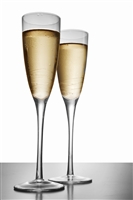A Guide to Buying Champagne

Do you angst over buying a bottle of Champagne or what we affectionately call "bubbly?" Do you wonder what's actually in the bottle? Will it be a waste of your hard earned money?
Champagne or Sparkling Wine?
We either buy Champagne or we buy sparkling wine. All Champagne is sparkling wine, but not all sparkling wine is Champagne. Champagne isn't necessarily better than sparkling wine. It depends on what you like and what you are willing to pay.
"Real Champagne"
The accurate use of the word "Champagne" refers only to wines made with grapes grown inside the Champagne region of France. These wines are also produced and bottled only in the Champagne region.
Sparkling Wine
A sparkling wine, made with grapes grown outside the French region of Champagne, is "sparkling wine" and is not entitled to the name "Champagne" on the label. Most countries in the world have agreed to not use the word "Champagne." The United States, by law, can and does use the word "Champagne," but the growing conditions (the soil and the climate) are certainly not the same, and the grapes may not be the same three grape varietals that must be used in French Champagne.
The Exception:
A few American producers and marketers of very inexpensive sparkling wine ($6.00 and under) place the word "Champagne" prominently on their labels, but America's best sparkling wine producers revere and respect the name "Champagne," and do not use the term for their products.
Here are two keys to buying quality sparkling wines:
- Look for the words "Methode Champenoise," "method of Champagne," or "Methode Traditionnelle" on the label.This assures the consumer that the bubbles in the bottle are produced using the time-honored fermentation method of the world's greatest Champagnes.
- Look for the words "Fermented in this Bottle," – not "Fermented in the Bottle."The word "this" means that the liquid in the bottle has never been transferred to or from any other bottle. This is an important distinction and it makes a difference in the purity of the bubbles.
This traditional French way of making a wine "sparkle" or "bubble" happens by allowing two fermentations: one in a stainless steel vat, and another in the actual glass bottle purchased in the retail store.
Methode Champenoise is a time consuming and expensive process – no matter where in the world the wine is made. The bottles must be "riddled" to remove the yeast.
Riddling turns, shakes and angles (tilts) the bottle to a vertical position and moves the yeast to the neck of the bottle. At the end of the riddling process, the bottles are sent through a freezing brine bath (neck down) and the liquid and yeast in the neck is flash-frozen. The bottles are tilted upward, the cap is snapped off and the frozen yeast/wine pops out. This labor-intensive process was originally done by hand, with a single Riddler turning, shaking and angling thousands of bottles by hand each day, for a period of several weeks.
Today, most Champagne and sparkling wine houses use automatic riddlers, known as gyropalettes, but a few special "Prestige" cuvees, as well as magnum bottles, still receive hand riddling.
Other Sparkling Wines, How They are Made, Why Their Bubbles are Inferior:
If the wine is not Methode Champenoise, there are three additional ways to get bubbles:
1. Transfer Method:
This process lets the wine go through its second fermentation in the bottle, but then the wine is emptied into a pressurized tank for yeast filtration and re-bottling. The "transfer" is inexpensive, as riddling is not required, but much -- and sometimes all, of the finest qualities of sparkling wine are lost in this process. The label will say "fermented in the bottle" -- NOT "fermented in this bottle."
2. The Charmat/Bulk Method:
This process artificially ages the wine by heating the juice of the grape. Fermentation takes place in large, pressurized tanks. This minimal aging, combined with bottling the wine under pressurized conditions, produces carbon dioxide (replacing the natural fermentation of sugar and yeast) as well as inferior "bubbles."
3. Injected Carbonation:
Just like your favorite soft drink, these wines get their bubbles from injected carbon dioxide. These are the cheapest of all sparkling wines, and once poured, the bubbles quickly disappear.
About the Importance of Quality Bubbles:The tinier the bubbles, the better. In a proper sparkling wine, a riot of tiny, tiny bubbles bead-up the bowl of the glass for a very long time. Only a good-quality sparkler has tiny bubbles in great abundance. They whet the appetite, caress the taste buds, and they look intoxicatingly beautiful. Natural effervescence (bubbles) cannot be replaced or equaled with "created" bubbles.
Comments (3)
As for the ink prices, after several flutes of a fantastic Brut, who cares? :)
How much ink can you get for US$ 15 ???